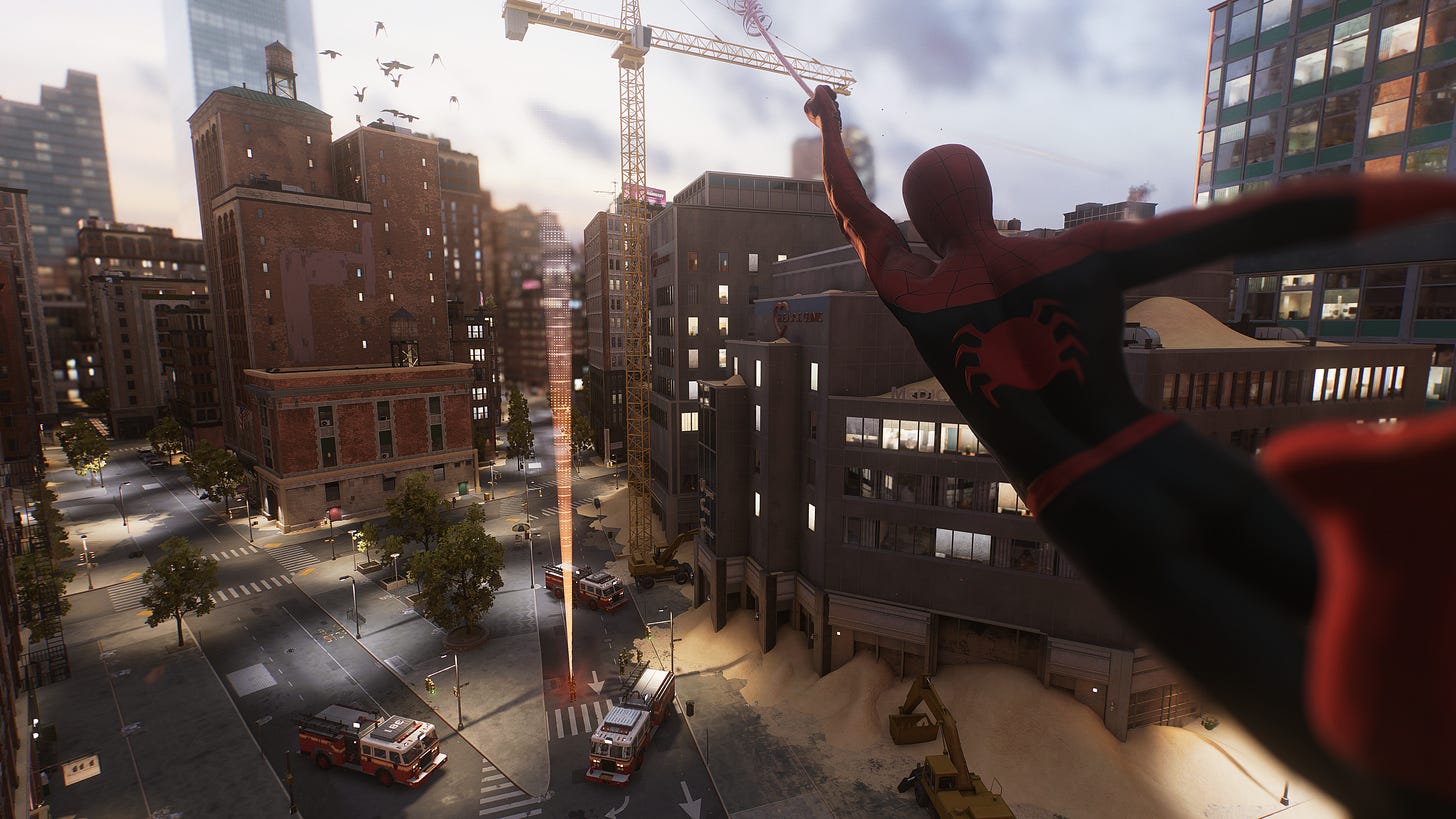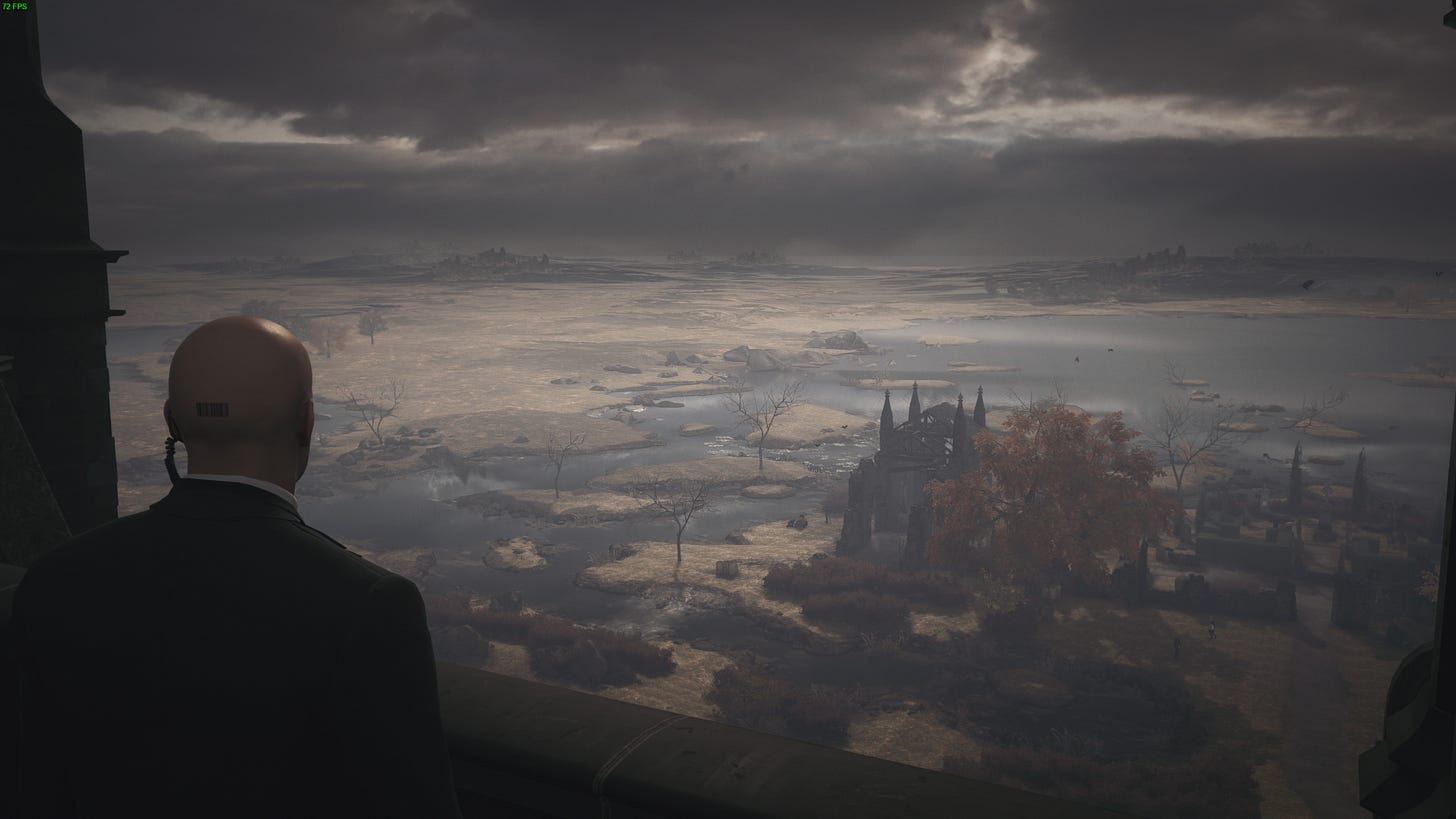Searching For Play In The Set Piece
Level and Quest Design, Part 1
This week, we're discussing level (& quest) design. I'm going to try to keep these posts around the 1000-word mark, on account of two reasons: 1) I hope making the posts shorter makes me write them more often and allows me to sustain, through activity, the many ideas that swirl in my mind; 2) gradually, I aim to render these thoughts into some form of practice, to concretely build the skills beneficial to game design, whether by practicing the writing of short stories, by building what Tim Cain would call "programming toys" (simple, prototypical mechanisms that must be fun at their core), or by actually using level editors (The Dark Mod, Shadowrun Campaigns, etc.) to author my own vision into reality. One of my secret hopes is that by establishing a solid-but-flexible work habit, I can also keep my health problems at bay or under control. We'll see.
Not too long ago, I found Spider-Man 2, a mega blockbuster video game, at a branch of my municipal public library. I had already been debating on whether to actually buy it (I had an itch for the NYC activity completionism), so I will start off by saying how shocked I was to simply loan it for free, and what an incredible power public libraries thus had over rendering accessible to all activities which, in the private sphere, might be much harder to attain: this might actually not be as universally beneficial as might initially appear, but I digress. With a reported budget of over 300$ million, this sequel cost three times more than its predecessor.
Yet, as I started to play, while I was initially just as shocked by the immersively kinetic feeling of web-slinging as one of the now TWO protagonists (Peter Parker & Miles Morales), I was very much set aback by the feeling of deja-vu and deja-played. Despite tripling an already huge budget, the game gave off many of the same vibes: spectacular cinematics combined with exciting QTE's (Quick-Time Events, requiring fast/precise button presses during a cutscene), amazing visual fidelity coupled with an extremely capable Photo Mode, iterative mission design (repetitive trifecta of stealth-combat-traversal), mostly disappointing narrative development of the characters, but especially of the story. Just as the first game, it became a slog to go through the sequel's main missions, as the villains presented no depth of character to become emotionally engaged to and the story followed extremely predictable steps: it's as if they had run out of ideas and/or money by the time they got to the point of putting together their game systems into a (narratively) coherent whole.
Except this time, I was a few years older & already engaged in more serious reflection with video game design as a whole. This got me thinking: what if the problem here was that the creation of these elaborate and jaw-dropping set pieces went too far from the actual level design that is at the basis of game design as a whole? Even without quests to guide the player through them, whether in a narrative or tutorializing or any other sense, levels can exist on their own where the player can put into practice the interactivity proper to the game they are playing: for example, I can kill monsters, receive gold & equipment from them, and navigate the rooms of a dungeon without any quest to "motivate" or "justify" the act: it can just be for fun, to experiment with different mechanics, etc.
Pinned for a next post: Develop the distinction & relationship between quest & level design
The question deserves repeating:
Are set pieces too far a departure from level design in the context of video/computer games?
Well, I actually went to do some research online about the term set piece, and I didn't have to look very long nor very far (Wikipedia, as usual, DELIVERS! with quotations to boot!) to find a pretty convincing and unambiguous answer:
In its original meaning, the term is used to label scenes that require a whole new set of stage scenery to be built. Most early movies were shot in large studios, with potentially expensive sets. When a screenplay would require a new set to be built, filmmakers would often make the scene a high point of the movie, to justify the expense. According to Adam O'Brien, a set piece is "a sequence in a film when we are invited to appreciate (if not consciously consider) the logistical efforts of the filmmaking process, including design, performance and recording."
The term is often used broadly to describe a sequence in which the film-maker's elaborate planning is considered to allow for the maximum pay-off for the audience, such as a thrilling action sequence or awe-inspiring science-fiction sequence. The term is often used to describe any scenes that are so essential to a film that they could not be edited out or skipped in the shooting schedule without seriously detracting from the enjoyability, intensity, impact, coherence or memorability of the finished work. Often, screenplays are written around a list of such set pieces, particularly in high-budget "event movies". The term is sometimes extended to refer to cinematic portions in video games. (My emphases.)
Without going here into the why's & how's, I argue that interfaces of play are, fundamentally and irreducibly, vectors of experimentation: "I wonder what will happen if I do this, if I go here, if I try this." Level design in games, whether they be role plays between kids or complex simulations running on the ubiquitous MOSFET transistors of today (look up the definition of MOSFET, it's interesting!), is supposed to provide a space & place enabling some form or type of experimentation. To loop back to the Wiki definition of set pieces: is it that unreasonable to believe that Spider-man 2's levels/missions were "written around" the set piece that was pre-defined before? "We have this big amusement park disaster idea, where the Spider-men have to zip around doing absolutely HEROIC stuff to save people and beat the baddies, how can we make it a bit interactable so that this still stays a game? Oh, we can do as usual: a bit of walking around, eventually some minigames, do some narrative tie-in, a big combat sequence to break up the amazement of the cutscene/set piece. Oh, you can't really put in any traversal? No worries, we'll do it a bit more in the next set-piece."
Obviously, I exaggerate and the game is an amazing technical achievement; the people who worked on it must be incredibly talented, skilled and deserve all the praise we can find for them. But a third of the way into the game's main missions, I've seen absolutely everything, and multiple times as well; except for challenges I can give to myself (eg. get a higher hit combo), there's no new interfaces of play, no new avenues of experimentation, lacking any weight or feeling of consequence; it's all rote repetition, the only pay-off being some flashy cutscenes. Those cutscenes are an absolute unit, no doubt, but... that's not why I want to play Spider-man, nor games in general, although I can accept that maybe I'm not part of the target audience, who maybe really crave visual spectacle.
To sum it all up, it strikes me quite strongly that in choosing to emphasize the game so much around set pieces and set piece cutscenes (for the audience in terms of impact, but also for the studio in terms of costs), the developers made a decision which, in the end, cost them a lot of what makes games actual enablers of experimentation. Set piece design was pushed so far as to almost make the notion of level design obsolete: missions feel the same, gameplay feels the same, and most importantly, spaces feel the same and never become a proper place.
That's it for this week. Next week, or maybe sooner if I can keep these as short as this one, I want to draw from a different example, where level design takes its sovereign place as initiator and vector of experimentation, without wholly excluding the notion of set piece altogether: Hitman 3's Dartmoor mansion level. If you're interested in the discussion, consider subscribing to the newsletter or leaving a comment.



